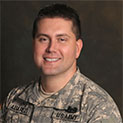


Posted June 27, 2013
MAJ Luis M. Alvarez, Ph.D., National Cancer Institute, Frederick, Maryland
 Healing large bone defects following a traumatic injury is one of the most challenging medical problems facing wounded Warriors. Therapies that promote regeneration of missing tissue and restoration of function typically rely on implants, many of which are seeded with bone marrow stem cells (MSCs) to accelerate healing. MSCs can come from a patient's own limited source or from a donor, which requires the patient to rely on life-long immunosuppression. MAJ Luis Alvarez, of the National Cancer Institute (NCI), hypothesized that modifying a biocompatible, inert scaffold by adding biologically active components could boost the patient's own MSC population at the injury site, thereby actively promoting regeneration and thus preventing the need for donor MSCs.
Healing large bone defects following a traumatic injury is one of the most challenging medical problems facing wounded Warriors. Therapies that promote regeneration of missing tissue and restoration of function typically rely on implants, many of which are seeded with bone marrow stem cells (MSCs) to accelerate healing. MSCs can come from a patient's own limited source or from a donor, which requires the patient to rely on life-long immunosuppression. MAJ Luis Alvarez, of the National Cancer Institute (NCI), hypothesized that modifying a biocompatible, inert scaffold by adding biologically active components could boost the patient's own MSC population at the injury site, thereby actively promoting regeneration and thus preventing the need for donor MSCs.
MAJ Alvarez was awarded a Fiscal Year 2010 Peer Reviewed Orthopaedic Research Program (PRORP) Career Development Award to establish his career in orthopaedic research and extend preliminary work he conducted with support from the Armed Forces Institute for Regenerative Medicine. With his mentors, Dr. George Muschler, Cleveland Clinic, and Dr. Linda Griffith, Massachusetts Institute of Technology, MAJ Alvarez discovered a novel peptide via phage display that stably binds to tricalcium phosphate (TCP), an implant material used to treat bone defects. The peptide can be fused to growth factors such as heregulin and epidermal growth factor, linking the engineered growth factors directly to TCP to promote MSC recruitment, proliferation, and regeneration. MAJ Alvarez is now evaluating the ability of the TCP-growth factor scaffolds to impact cell survival and proliferation of MSCs in a three-dimensional cell culture system that simulates the wound environment, while collaborators at the Cleveland Clinic have already started to test the efficacy of the system on bone regeneration in a large animal model.
MAJ Alvarez is currently developing the novel protein linking technology into one that can coat orthopaedic implants with any bio-active growth factor or anti-infective of choice in a single step. MAJ Alvarez hopes his group's discoveries can transform the way large bone injuries are treated and reduce the need for limb amputation by enhancing the regenerative potential of bone. With his support from the PRORP, MAJ Alvarez established the Regenerative Biology Research Group within the NCI. Dr. Alan Perantoni, Director of the Cancer and Developmental Biology Laboratory, hosts MAJ Alvarez's group and enabled the establishment of this new research activity, which complements the NCI's core mission. This creates unique research synergies that not only inform possible treatments for bone loss resulting from various types of cancer but also allows MAJ Alvarez to fully leverage PRORP support to develop treatments for wounded Warriors with traumatic bone injuries.
Publication:
Hong J, Alvarez LM, Shah NJ, Cho Y, Kim B-S, Griffith LG, Char K and Hammond PT. 2012. Multilayer thin-film coatings capable of extended programmable drug release: Application to human mesenchymal stem cell differentiation. Drug Delivery and Translational Research 2(5):375-383.
Links:














